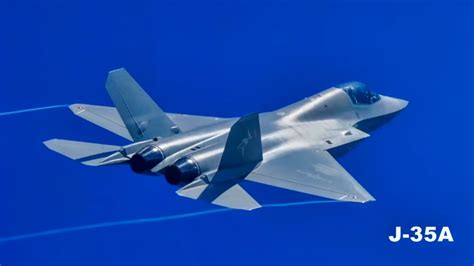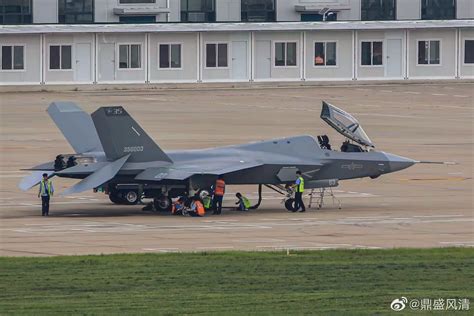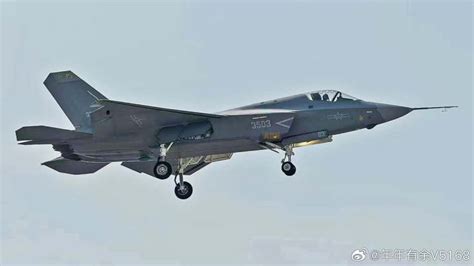
New images have surfaced, offering the clearest look yet at China’s J-35 naval stealth fighter, signaling a significant advancement in the country’s carrier-based aviation capabilities and potentially reshaping the balance of power in the Indo-Pacific region. The twin-engine fighter, designed for operations from China’s growing fleet of aircraft carriers, is poised to rival the United States’ F-35C in terms of stealth and performance, bolstering China’s ability to project power far beyond its shores.
J-35 Stealth Fighter Images Highlight China’s Growing Carrier Power
Newly released images provide an unprecedented glimpse into the development of China’s J-35 naval stealth fighter, a crucial component in the modernization of the People’s Liberation Army Navy (PLAN)’s aircraft carrier air wings. The fighter, which is expected to operate from China’s existing carriers, Liaoning and Shandong, as well as the more advanced Fujian, represents a substantial leap in China’s naval aviation capabilities. Analysts suggest that the J-35 could achieve operational status by 2025, significantly altering the strategic landscape in the Indo-Pacific.
The images, circulating on Chinese social media and subsequently analyzed by defense experts worldwide, showcase a mature prototype with several key design features indicative of a carrier-based stealth fighter. These include folding wings for more efficient storage on aircraft carriers, a reinforced landing gear designed to withstand the stresses of carrier landings, and advanced stealth shaping optimized to minimize radar cross-section.
“The J-35 is a significant development for the PLAN, providing it with a carrier-borne stealth fighter comparable to the U.S. Navy’s F-35C,” explains Thomas Shugart, an adjunct senior fellow at the Center for a New American Security and a former U.S. Navy officer. “This aircraft substantially enhances the offensive and defensive capabilities of China’s aircraft carrier fleet and demonstrates a commitment to modernizing its naval forces.”
The development of the J-35 reflects China’s broader strategy of developing a blue-water navy capable of operating globally. With the introduction of advanced aircraft carriers and accompanying stealth fighters, China aims to project power, protect its maritime interests, and challenge the dominance of the United States Navy in the region.
Design and Capabilities
The J-35’s design borrows heavily from the Shenyang FC-31, a fifth-generation stealth fighter previously marketed for export. However, the naval variant incorporates several modifications tailored for carrier operations. Folding wings are essential for maximizing the number of aircraft that can be accommodated on a carrier’s deck and in its hangar. The reinforced landing gear is critical for absorbing the immense forces generated during carrier landings, where aircraft are typically brought to a stop using arresting gear.
The fighter’s stealth shaping, characterized by its angled surfaces and internal weapons bays, is designed to minimize its radar cross-section, making it difficult to detect and track by enemy radar systems. This stealth capability allows the J-35 to penetrate enemy airspace more effectively and increases its survivability in contested environments.
The J-35 is expected to be equipped with advanced avionics, including an active electronically scanned array (AESA) radar, which provides superior situational awareness and targeting capabilities. The AESA radar can track multiple targets simultaneously and is resistant to electronic jamming. The fighter will also likely incorporate advanced electronic warfare systems to further enhance its survivability.
The J-35 is projected to carry a variety of air-to-air and air-to-surface missiles, as well as precision-guided bombs. Its internal weapons bays will allow it to maintain its stealth profile while carrying a significant payload. The fighter may also be equipped with external hardpoints for carrying additional ordnance, albeit at the cost of increased radar cross-section.
Implications for Regional Security
The introduction of the J-35 has significant implications for regional security in the Indo-Pacific. The fighter will enhance China’s ability to project power in the region, potentially altering the balance of power in areas such as the South China Sea and the Taiwan Strait.
The J-35’s stealth capabilities will pose a significant challenge to existing air defense systems in the region. Countries reliant on older radar technologies may find it difficult to detect and track the J-35, potentially requiring them to invest in more advanced radar systems or electronic warfare capabilities.
The J-35 will also likely increase the risk of miscalculation and escalation in the region. The fighter’s ability to penetrate enemy airspace undetected could lead to heightened tensions and a greater risk of accidental encounters.
The United States and its allies are closely monitoring the development of the J-35 and are taking steps to counter its potential impact. These include investing in their own advanced fighter aircraft, such as the F-35, and strengthening their air defense capabilities.
Comparison with the F-35C
The J-35 is often compared to the U.S. Navy’s F-35C, the carrier-based variant of the F-35 Joint Strike Fighter. Both aircraft are designed to operate from aircraft carriers and incorporate advanced stealth technologies. However, there are also some key differences between the two fighters.
The F-35C is a single-engine fighter, while the J-35 is a twin-engine fighter. Some analysts believe that the twin-engine configuration of the J-35 may provide it with greater range and payload capacity compared to the F-35C. However, the single-engine design of the F-35C may offer advantages in terms of maintenance and operating costs.
The F-35C has a longer operational history than the J-35 and has been extensively tested and evaluated. The J-35 is still in the developmental phase, and its actual performance capabilities remain to be fully determined.
Despite these differences, both the J-35 and the F-35C represent a significant advancement in carrier-based aviation. They both incorporate advanced stealth technologies, avionics, and weapons systems that will enhance the capabilities of their respective navies.
China’s Aircraft Carrier Program
The development of the J-35 is closely linked to China’s ambitious aircraft carrier program. China currently operates two aircraft carriers, the Liaoning and the Shandong, both of which are based on a ski-jump design. The Liaoning is a refurbished Soviet-era carrier, while the Shandong is China’s first domestically built carrier.
China’s third aircraft carrier, the Fujian, is significantly more advanced than its predecessors. The Fujian features a flat deck and electromagnetic catapults, similar to those used on U.S. Navy aircraft carriers. This will allow the Fujian to launch a wider range of aircraft, including heavier fighters and support aircraft. The Fujian is expected to enter service in the coming years and will further enhance China’s naval power projection capabilities.
The J-35 is expected to be a key component of the Fujian‘s air wing. Its stealth capabilities and advanced avionics will complement the carrier’s modern launch systems, allowing it to project power far beyond China’s shores.
Expert Opinions
Defense analysts and military experts have offered varied perspectives on the J-35’s significance. Some emphasize its role in challenging U.S. naval dominance, while others highlight the technological advancements it represents for China’s aerospace industry.
“The J-35 represents a major step forward for China’s naval aviation capabilities,” notes Dr. Malcolm Davis, a senior analyst at the Australian Strategic Policy Institute. “It will provide the PLAN with a credible carrier-based stealth fighter that can compete with the F-35C. This will significantly enhance China’s ability to project power in the Indo-Pacific.”
However, some experts caution against overstating the J-35’s capabilities. “While the J-35 is undoubtedly a significant achievement for China, it is important to remember that it is still in the developmental phase,” says Rick Fisher, a senior fellow at the International Assessment and Strategy Center. “Its actual performance capabilities remain to be fully determined, and it is unlikely to match the F-35C in all areas.”
Future Developments
The development of the J-35 is likely to continue in the coming years, with further refinements and improvements expected to be incorporated into the design. China may also develop additional variants of the J-35, such as an electronic warfare version or a reconnaissance version.
The J-35 is also likely to be exported to other countries in the future. China has already marketed the Shenyang FC-31 for export, and the J-35 could be an attractive option for countries seeking a modern, carrier-based stealth fighter.
The Bigger Picture: China’s Military Modernization
The J-35 is just one component of China’s broader military modernization program. Over the past several decades, China has invested heavily in modernizing its armed forces, including its navy, air force, and army. This modernization program is aimed at transforming China into a world-class military power capable of defending its interests and projecting power globally.
China’s military modernization program has raised concerns among some countries in the region, particularly the United States and its allies. These countries are concerned that China’s growing military power could be used to assert its territorial claims in the South China Sea or to threaten Taiwan.
China has consistently stated that its military modernization program is purely defensive in nature and that it has no intention of using its military power to threaten other countries. However, China’s actions in the South China Sea and its increasing military presence in the region have led to skepticism about its intentions.
Conclusion
The emergence of the J-35 naval stealth fighter represents a significant milestone in China’s military modernization program and a major boost to its carrier-based aviation capabilities. The fighter is poised to enhance China’s power projection capabilities and potentially alter the strategic balance in the Indo-Pacific region. While questions remain regarding its ultimate performance and operational readiness, the J-35 undoubtedly signals China’s determination to become a leading naval power. Its development underscores the ongoing technological competition between China and the United States, and the need for continued vigilance and strategic adaptation in the face of evolving military capabilities. The world watches as the J-35 prepares to take its place in the skies above the world’s oceans.
Frequently Asked Questions (FAQ)
1. What is the J-35?
The J-35 is a Chinese naval stealth fighter designed to operate from aircraft carriers. It is a twin-engine aircraft with stealth shaping, folding wings, and a reinforced landing gear, making it suitable for carrier-based operations. It is considered a fifth-generation fighter, comparable to the U.S. Navy’s F-35C.
2. What are the key features of the J-35?
The key features of the J-35 include:
- Stealth shaping: Designed to minimize radar cross-section, making it difficult to detect.
- Folding wings: Allows for more efficient storage on aircraft carriers.
- Reinforced landing gear: Designed to withstand the stresses of carrier landings.
- Advanced avionics: Likely to include an active electronically scanned array (AESA) radar and electronic warfare systems.
- Internal weapons bays: Allows it to carry a payload while maintaining stealth.
3. How does the J-35 compare to the U.S. Navy’s F-35C?
Both the J-35 and the F-35C are carrier-based stealth fighters. The J-35 is a twin-engine fighter, while the F-35C is a single-engine fighter. The F-35C has a longer operational history and has been extensively tested. The J-35 is still in the developmental phase, and its actual performance capabilities remain to be fully determined. Some analysts suggest the twin-engine design of the J-35 may offer greater range and payload capacity compared to the F-35C.
4. What is the significance of the J-35 for China’s military?
The J-35 is a significant development for China’s military because it:
- Enhances China’s power projection capabilities in the Indo-Pacific region.
- Provides the People’s Liberation Army Navy (PLAN) with a credible carrier-based stealth fighter.
- Demonstrates China’s commitment to modernizing its naval forces.
- Challenges the dominance of the United States Navy in the region.
- Represents a major step forward in China’s aerospace industry.
5. What are the potential implications of the J-35 for regional security?
The potential implications of the J-35 for regional security include:
- Altering the balance of power in areas such as the South China Sea and the Taiwan Strait.
- Posing a challenge to existing air defense systems in the region.
- Increasing the risk of miscalculation and escalation due to its stealth capabilities.
- Potentially prompting countries in the region to invest in more advanced air defense systems and fighter aircraft.
Further Analysis:
The unveiling of advanced images of the J-35 coincides with a period of heightened geopolitical tension in the Indo-Pacific. China’s assertive behavior in the South China Sea, its increasing military activity near Taiwan, and its growing economic and military influence in the region have raised concerns among neighboring countries and the United States. The J-35’s development can be viewed as a direct response to the perceived need to safeguard its interests and to counterbalance the military presence of the United States and its allies in the region.
The J-35’s capabilities extend beyond mere territorial defense. Its advanced stealth technologies and long-range strike capabilities suggest an ambition to project power far beyond China’s immediate periphery. This could include conducting operations in the Indian Ocean, supporting China’s economic interests in Africa, or participating in peacekeeping operations around the world.
The J-35 also represents a significant achievement for China’s aerospace industry. The development of a carrier-based stealth fighter requires a high level of technological expertise and manufacturing capabilities. China’s success in developing the J-35 demonstrates its growing ability to design and produce advanced military hardware.
However, the J-35 is not without its challenges. The fighter is still in the developmental phase, and its actual performance capabilities remain to be fully determined. It is also likely to be expensive to operate and maintain, requiring significant investments in training, logistics, and support infrastructure.
Moreover, the J-35’s effectiveness will depend on a variety of factors, including the quality of its pilots, the capabilities of its support systems, and the tactics and strategies employed by the PLAN. The fighter is not a silver bullet, and its success will depend on its integration into a broader naval strategy.
Despite these challenges, the J-35 represents a significant step forward for China’s military modernization program. It is a symbol of China’s growing power and its ambition to become a leading global military power. Its development will undoubtedly have a significant impact on the strategic balance in the Indo-Pacific region and beyond.
The emergence of the J-35 also highlights the importance of technological competition in the modern era. The United States and its allies must continue to invest in advanced military technologies in order to maintain their competitive edge. This includes developing new fighter aircraft, improving air defense systems, and enhancing electronic warfare capabilities.
The J-35 serves as a reminder that the global military landscape is constantly evolving. Countries must be prepared to adapt to these changes and to develop new strategies and tactics in order to protect their interests and maintain their security. The J-35 is not just a new fighter aircraft; it is a symbol of a changing world. The development of the J-35 is a clear indication that China is serious about becoming a major naval power. It remains to be seen how the J-35 will perform in actual combat, but its very existence is a testament to China’s growing military capabilities and its increasing assertiveness on the world stage.
The next few years will be crucial in determining the J-35’s impact on regional security. As the fighter enters service with the PLAN, it will be closely watched by the United States and its allies. The fighter’s performance in exercises and deployments will provide valuable insights into its capabilities and its potential role in future conflicts. The development and deployment of the J-35 also underscores the importance of arms control and confidence-building measures. As China’s military power grows, it is essential to establish clear rules of engagement and to promote transparency in order to reduce the risk of miscalculation and escalation. This includes engaging in dialogue with China on issues such as maritime security, cyber warfare, and arms proliferation.
Ultimately, the J-35 is just one piece of a larger puzzle. The future of the Indo-Pacific region will depend on a variety of factors, including the actions of China, the United States, and other regional powers. The J-35 is a powerful symbol of China’s growing military might, but it is not the only factor that will shape the region’s future. Diplomatic efforts, economic cooperation, and cultural exchange will also play a crucial role in promoting peace and stability in the region.
The J-35’s development also raises questions about the future of aircraft carriers. Some analysts have argued that aircraft carriers are becoming increasingly vulnerable to attack from advanced anti-ship missiles and submarines. However, others maintain that aircraft carriers remain a valuable asset for projecting power and responding to crises.
The J-35’s ability to operate from aircraft carriers will undoubtedly enhance the capabilities of these platforms. The fighter’s stealth capabilities and long-range strike capabilities will make it a formidable threat to potential adversaries. However, the J-35’s effectiveness will also depend on the carrier’s ability to defend itself from attack.
The development of the J-35 underscores the importance of investing in advanced defensive systems, such as anti-missile defenses and electronic warfare capabilities. These systems are essential for protecting aircraft carriers from attack and ensuring their continued viability as a power projection platform.
The J-35 is a complex and multifaceted issue with far-reaching implications for regional and global security. It is a symbol of China’s growing power, a testament to its technological prowess, and a challenge to the existing international order. It remains to be seen how the J-35 will ultimately shape the future of the Indo-Pacific region, but its impact is sure to be significant. The J-35 is not merely a weapon; it is a strategic tool, a diplomatic instrument, and a symbol of national ambition. It represents China’s vision for its role in the world and its determination to shape the future of the Indo-Pacific region. The J-35 has undeniably altered the calculations of military strategists and policymakers around the world, prompting a reassessment of existing defense strategies and alliances. The ripple effects of this technological advancement will continue to be felt for years to come, as nations grapple with the implications of a more assertive and technologically advanced China.









